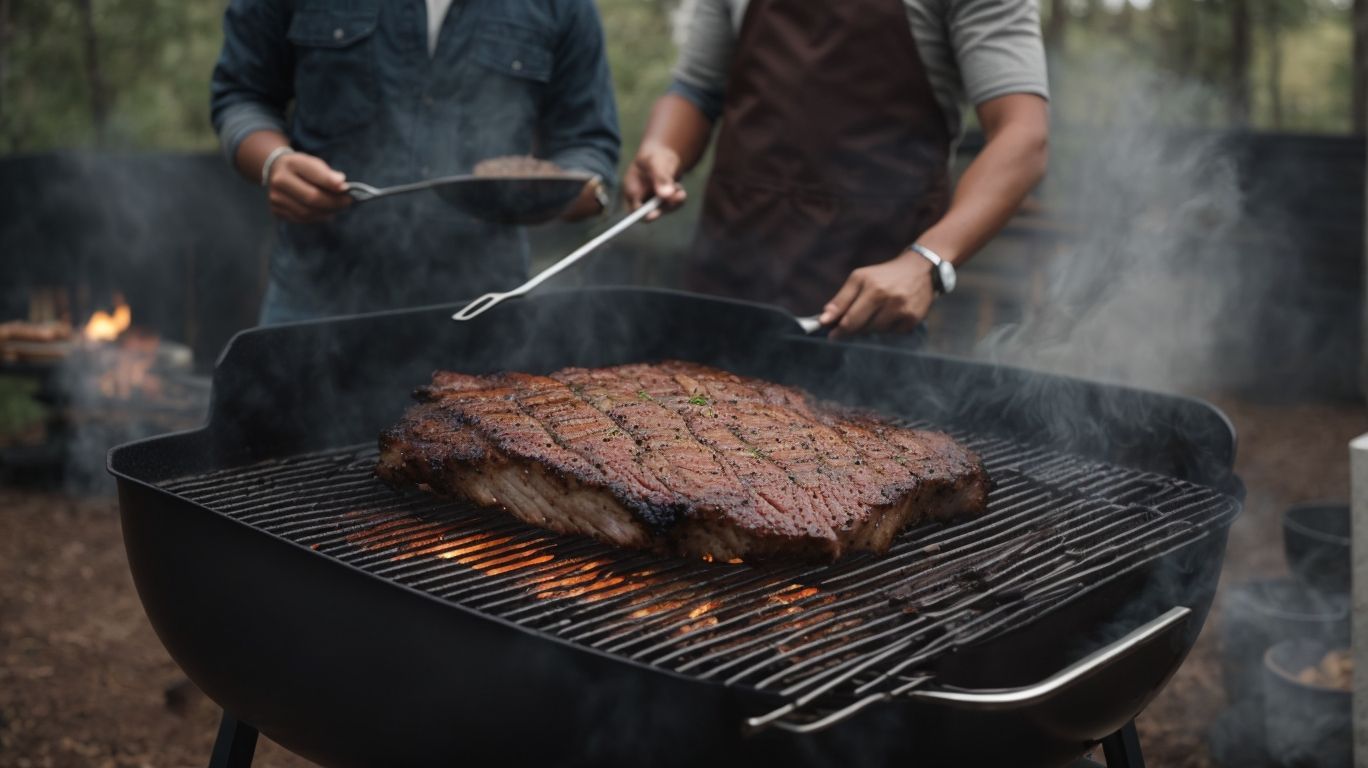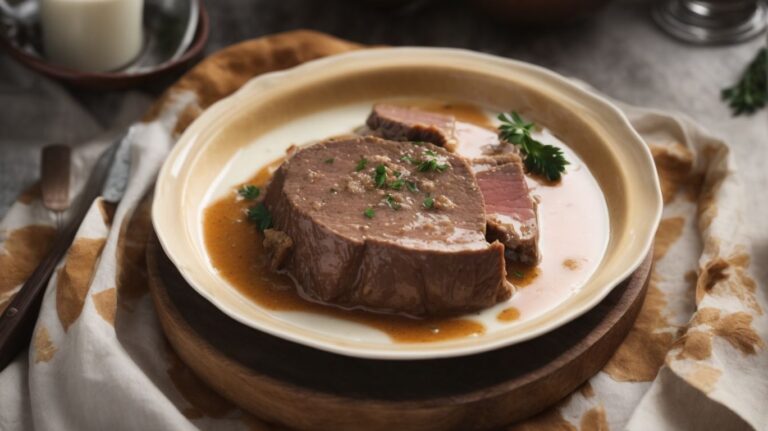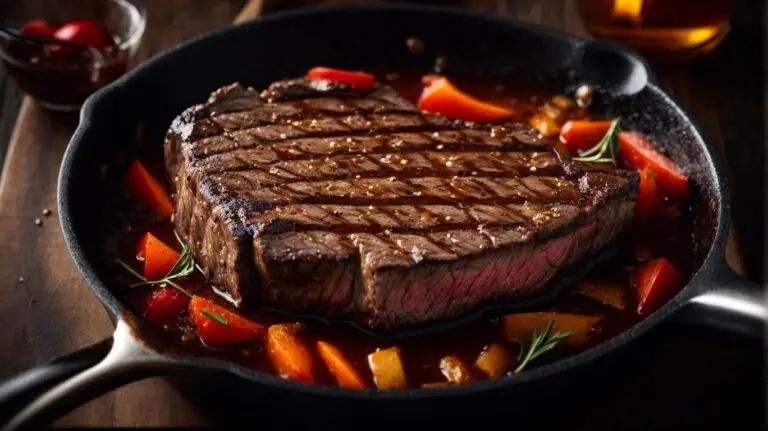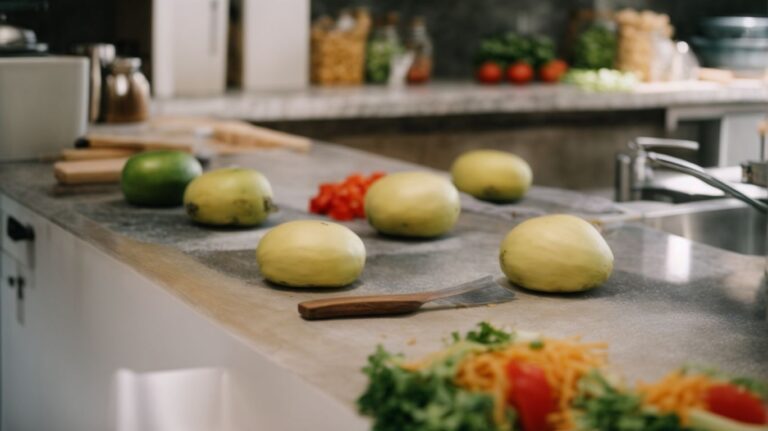How to Cook a Brisket Without a Smoker?
Craving a delicious brisket but don’t have a smoker? No worries, we’ve got you covered!
We explore why cooking brisket without a smoker is a great option for many home cooks. From cost-effective alternatives to different cooking methods such as oven roasting, slow cooker, and Instant Pot, we guide you through preparing and cooking the perfect brisket.
Stay tuned for valuable tips on choosing the right cut, trimming the fat, seasoning, and knowing when your brisket is done. Get ready to slice, serve, and enjoy your mouthwatering brisket like a pro!
Key Takeaways:
What is Brisket?
Brisket is a cut of meat from the breast or lower chest of beef or veal, known for its rich flavor and tenderness.
One of the defining features of brisket is the prominent fat layer that runs through the meat, contributing to its juicy and succulent texture when cooked properly. There are two primary types of brisket cuts: the brisket flat, which is leaner and uniform in thickness, and the brisket with a point, which contains more marbling and tends to be juicier. Brisket is a popular choice for slow-cooking methods such as smoking or braising, as the long cooking time allows the meat to become incredibly tender.
When preparing brisket, many recipes call for the use of beef broth to enhance the flavors of the meat and keep it moist during the cooking process. The versatile nature of brisket allows it to be used in various dishes, from classic barbecue brisket to hearty stews and sandwiches.
Why Cook Brisket Without a Smoker?
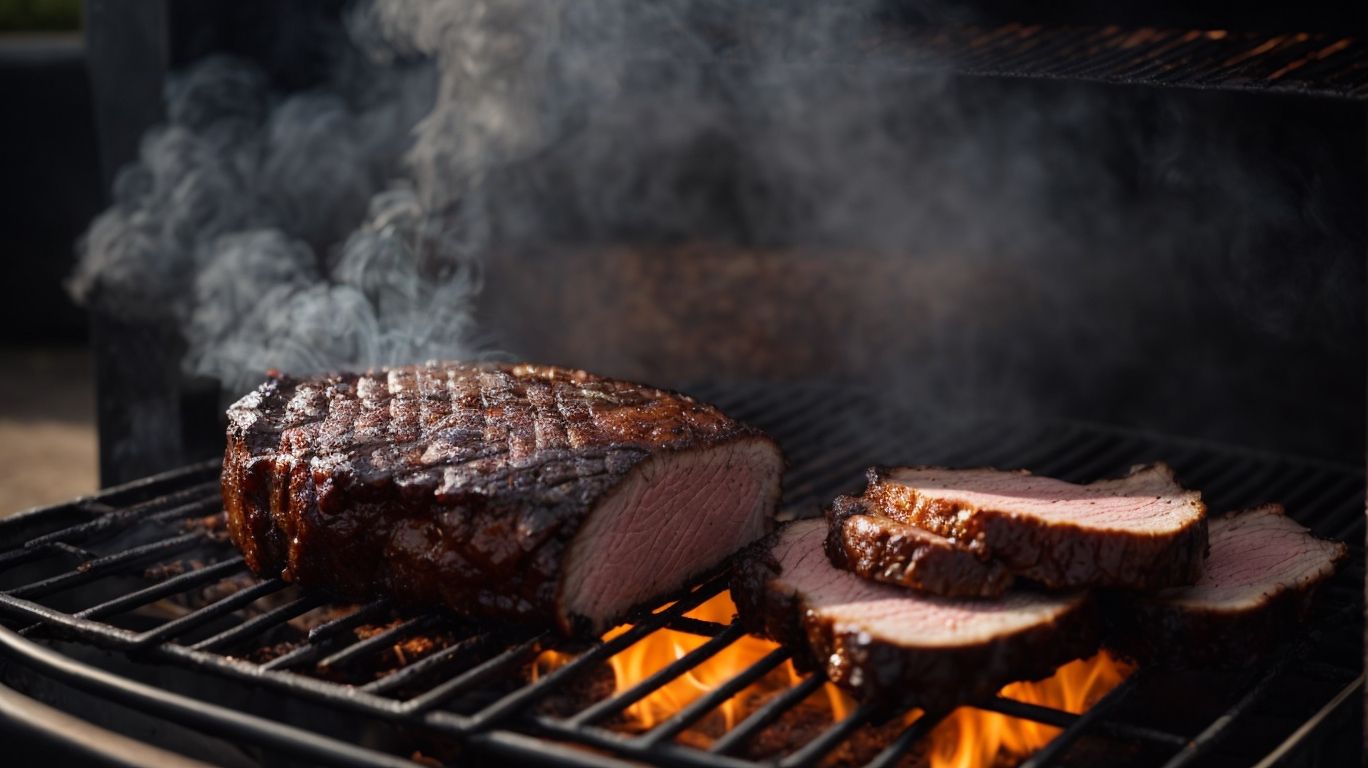
Credits: Poormet.Com – Austin Martin
Cooking brisket without a smoker may be preferred due to cost, space constraints, or time limitations.
Regarding preparing brisket without a smoker, one cost-effective option is to utilize your conventional oven. Slow-cooking brisket in the oven yields tender and juicy results, making it a popular alternative to traditional smoking methods. Opting for this method can be space-saving, especially for individuals who do not have outdoor space for a smoker.
Another time-efficient approach is to incorporate liquid smoke into your cooking process. Liquid smoke provides that characteristic smoky flavor without the need for a smoker, allowing you to enjoy delicious brisket in a fraction of the time.
Smokers can be expensive
Investing in a high-quality smoker can be a significant expense for home cooks looking to prepare brisket.
For those on a tighter budget, there are alternative options available that can still deliver delicious smoked flavors. One cost-effective approach is to utilize a charcoal grill as a makeshift smoker by setting it up for indirect heat. Dry rubs and smoked paprika can be used to enhance the flavors of meats cooked in this manner, mimicking the essence of traditional smoking methods without the need for a dedicated smoker. With a bit of creativity and experimentation, home cooks can achieve mouthwatering smoked dishes even without a hefty investment in specialized equipment.
Limited space or resources
Limited kitchen space or access to specialized cooking equipment can prompt individuals to seek smoker-free brisket recipes.
One practical solution for achieving that sought-after smoky flavor in a smaller kitchen is utilizing a roasting pan and wire rack. By creating a makeshift smoker environment within your oven, you can infuse the brisket with delicious smokiness without the need for a traditional smoker. Simply place wood chips in the roasting pan, set the wire rack on top to hold the brisket, and tightly seal the pan with foil to trap the smoke. This method allows for slow cooking and smoking, resulting in a tender and flavorful brisket.
Time constraints
For those with busy schedules, opting for smoker-free brisket recipes can save valuable cooking time and effort.
When tackling brisket without a smoker, it’s crucial to focus on achieving that perfect combination of tender meat and rich flavor. One efficient technique involves using your oven and a lower temperature setting to ensure a slow cooking process that allows the flavors to develop fully.
By embracing the method of slow cooking, you can let the meat tenderize gradually over time, resulting in a melt-in-your-mouth texture that is truly irresistible. Controlling the cooking temperature and monitoring the time spent in the oven are essential steps in ensuring the brisket reaches its optimal taste and tenderness.
What are the Different Ways to Cook Brisket Without a Smoker?
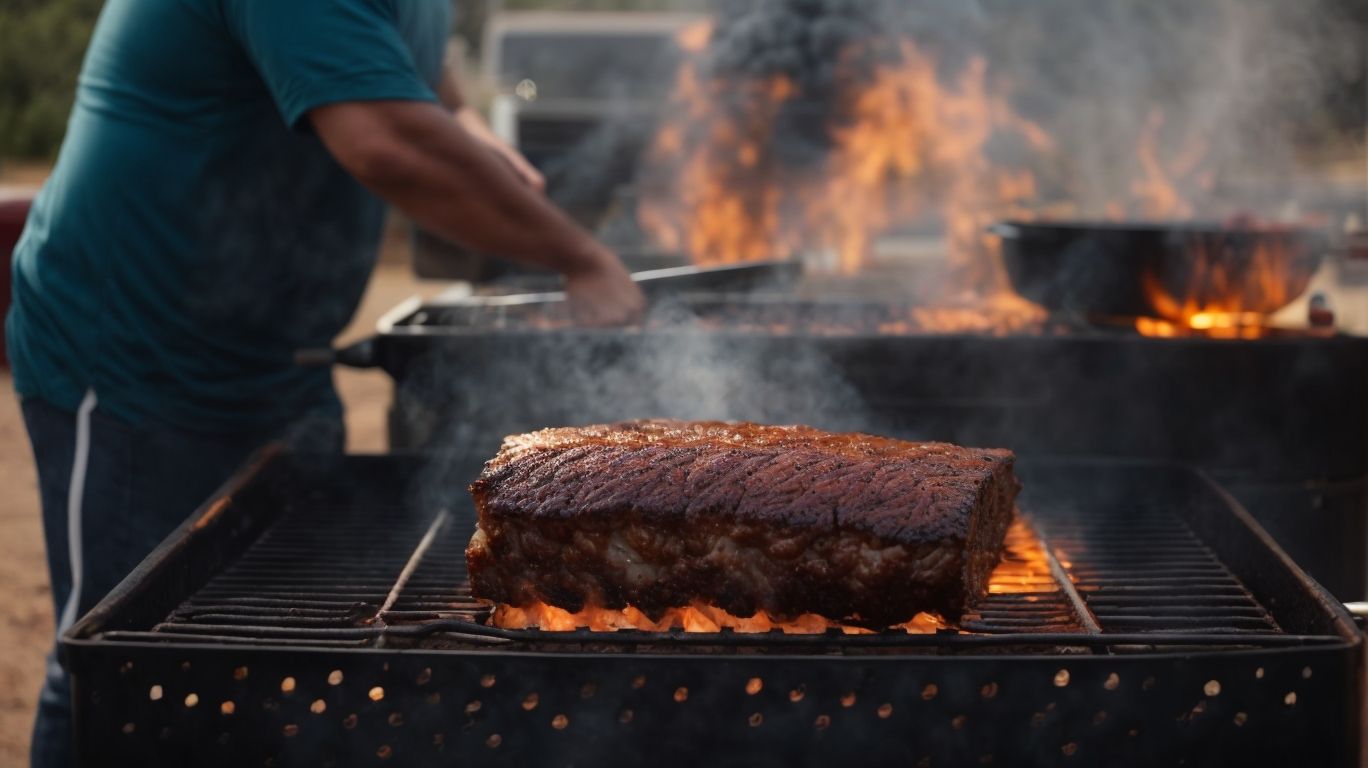
Credits: Poormet.Com – Logan King
There are several methods to cook brisket without a smoker, including oven roasting, slow cooker, and Instant Pot preparation.
When preparing brisket in the oven, you can still achieve that smoky flavor by utilizing liquid smoke or a marinade featuring Worcestershire sauce. This method involves low and slow cooking, ensuring the meat remains tender and juicy.
In contrast, using a slow cooker for brisket involves setting it and forgetting it, allowing the flavors to meld together over hours of gentle cooking. This technique is perfect for those with busy schedules or those who want a hands-off approach to cooking.
If you opt for Instant Pot cooking, you benefit from the quickness of pressure cooking, which can reduce cooking time significantly while still producing fork-tender brisket. This method is great for those who want the flavors to infuse quickly without compromising on taste or tenderness.
Oven Roasting
Oven roasting brisket offers a convenient and flavorful alternative to traditional smoking methods, allowing for tender and juicy results.
To start, preheat your oven to 250°F for low and slow cooking. Season your brisket generously with a rub that includes smoked paprika, salt, pepper, garlic powder, and brown sugar for a well-balanced flavor profile.
Place the brisket fat-side up in a roasting pan and insert a meat thermometer into the thickest part of the meat to monitor the internal temperature.
Throughout the cooking process, consider basting the brisket with its own juices or a homemade barbecue sauce every hour to keep it moist and flavorful. This will also help develop a nicely caramelized crust.
Slow Cooker
Utilizing a slow cooker for brisket preparation ensures a hassle-free cooking experience with succulent and well-seasoned results.
One of the significant advantages of using a slow cooker for brisket is the tenderization process that occurs over an extended period, resulting in melt-in-your-mouth texture that can’t be achieved with quick-cooking methods. The slow cooker allows the flavors of the beef broth and dry rub to infuse deeply into the meat, creating a rich and savory taste profile that is sure to impress your taste buds.
Instant Pot
The Instant Pot offers a quick and efficient method to cook brisket, retaining moisture and flavor in a fraction of the time required for traditional methods.
Using an Instant Pot for brisket allows you to skip the lengthy hours typically spent slow-cooking in a conventional oven or roasting pan. The pressure cooking function of the Instant Pot speeds up the process significantly, perfect for busy weeknights or last-minute gatherings. To prepare brisket in an Instant Pot, start by placing a wire rack at the bottom to elevate the meat and prevent it from becoming soggy in its own juices.
Tips for Preparing the Brisket
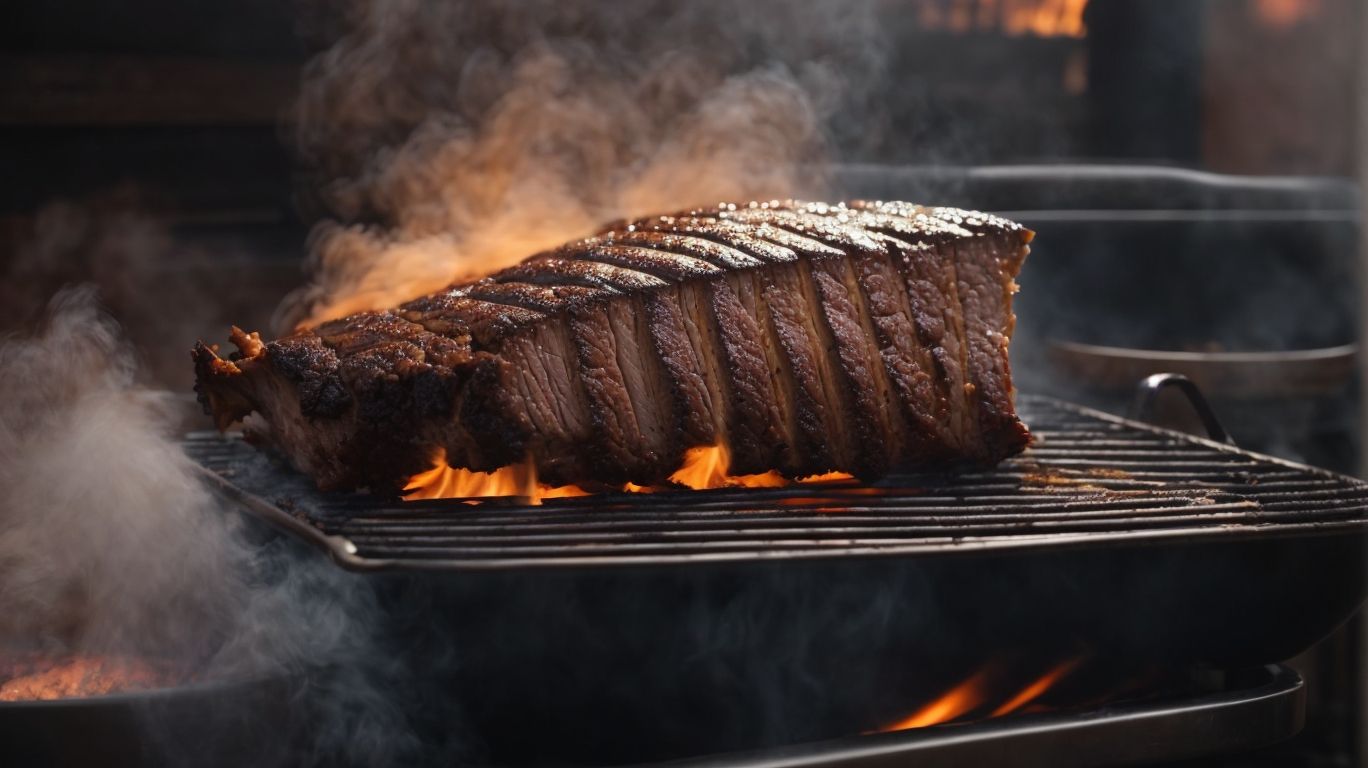
Credits: Poormet.Com – Ralph Hernandez
To ensure a successful brisket dish, it is essential to select the right cut, trim excess fat, and season the meat adequately.
Regarding choosing the right cut of brisket, opting for the marbled choice is crucial. The fat layer within the meat ensures a juicy and flavorful end result. Before cooking, take the time to trim excess fat to avoid a greasy finish. A helpful technique is to leave just a thin layer of fat to enhance moisture during the cooking process.
For seasoning, consider using a dry rub to add depth of flavor to the meat. The combination of spices and herbs in a dry rub not only enhances the taste but also forms a delicious crust during cooking, locking in the moisture and flavor of the brisket.
Choosing the right cut of brisket
Selecting the appropriate cut of brisket, such as brisket flat or brisket with a point, can significantly impact the final texture and taste of the dish.
Brisket flat, also known as the leaner portion, has less fat layer compared to the brisket with a point. The point cut contains more marbling, resulting in a juicier and more flavorful end product. When cooked low and slow, the brisket flat tends to be firmer and leaner while the brisket point renders a rich, succulent texture.
For melt-in-your-mouth burnt ends, the point cut is ideal due to its higher fat content which renders down during cooking, creating a luscious and savory finish. On the other hand, if you prefer a leaner cut for slicing, the brisket flat is perfect for achieving tender yet lean slices.
Trimming the fat
Properly trimming excess fat from the brisket ensures a more balanced and flavorful end result, preventing overly greasy or tough portions.
For achieve an optimal fat layer, begin by locating the thicker regions of fat on the brisket. Use a sharp knife to remove excessive pockets of fat, taking care not to cut into the meat itself. Trimming the fat to about 1/4 inch thickness will enhance the meat’s tenderness and allow it to absorb seasonings and smoke flavors more effectively.
Consider dry brining the brisket before cooking. This method involves generously seasoning the meat with a dry rub mixture and letting it sit in the refrigerator for several hours or overnight. Dry brining not only adds flavor but also helps to draw out excess moisture, resulting in a more concentrated taste and improved texture.
Seasoning the brisket
Applying a well-balanced dry rub or marinade to the brisket can elevate its flavor profile, resulting in a more aromatic and savory dish.
Seasoning plays a crucial role in not only enhancing the taste but also tenderizing the meat, making it juicier and more flavorful. Smoked paprika is a popular ingredient in dry rubs, adding a deep, smoky flavor. Some common dry rub recipes include a blend of spices like garlic powder, onion powder, brown sugar, salt, pepper, and Worcestershire sauce. For marinades, consider flavor combinations such as soy sauce, honey, ginger, and a hint of citrus for a sweet and tangy profile.
Cooking the Brisket
Mastering the art of cooking brisket involves selecting the right method, monitoring temperature and time, and ensuring the meat reaches the desired level of tenderness.
One popular method for cooking brisket is utilizing the foil wrapping technique. This involves tightly wrapping the seasoned meat in aluminum foil during the cooking process, which helps retain moisture and enhances tenderness.
Alternatively, using barbecue sauce can add a flavorful dimension to your brisket. Consider basting the meat with a homemade or store-bought barbecue sauce during the last phase of cooking to create a sticky and tangy glaze.
Oven Roasting Method
The oven roasting method for cooking brisket allows for consistent heat distribution, resulting in tender meat with a well-developed flavor profile.
When preparing to roast a brisket in the oven, it is recommended to preheat the oven to 275°F (135°C) for slow cooking or 325°F (163°C) for a more traditional approach. For a 3-4 pound brisket, the cooking time usually ranges from 3-4 hours at the lower temperature to 2-3 hours at the higher temperature, until the internal temperature reaches around 190-205°F (88-96°C).
To enhance the flavor, consider seasoning the brisket with a mix of spices, including smoked paprika, and basting occasionally with the pan juices or a marinade. Using a roasting pan and a wire rack elevates the meat, allowing for proper airflow and drainage of excess fat, resulting in a more even cook.
It’s essential to monitor the internal temperature with a meat thermometer to ensure the brisket is cooked to the desired doneness, offering juicy bites of flavorful meat.
Slow Cooker Method
Using a slow cooker to prepare brisket ensures a moist and flavorful outcome, requiring minimal hands-on effort for a satisfying meal.
One essential step when slow cooking brisket is to sear the meat beforehand to lock in those juices and enhance the flavor profile. This can easily be done by heating a skillet and browning the brisket on all sides before placing it in the slow cooker.
To add depth to the dish, consider adding beef broth or a blend of your favorite seasonings to the cooking liquid. This will infuse the meat with rich flavors as it simmers over several hours.
For optimal tenderness, set the slow cooker to low heat and allow the brisket to simmer for 6-8 hours, or until it reaches the desired level of doneness.
Instant Pot Method
Employing the Instant Pot method for cooking brisket offers a quick and efficient alternative, resulting in succulent meat with intensified flavors.
When using the Instant Pot for cooking brisket, the pressure cooking process works wonders in tenderizing tougher cuts of meat, allowing them to cook in a fraction of the time it would take using traditional methods. This method not only helps to retain the natural juices and flavors of the meat but also infuses them with the added elements of liquid smoke and Worcestershire sauce for a mouthwatering result.
How to Tell When the Brisket is Done?
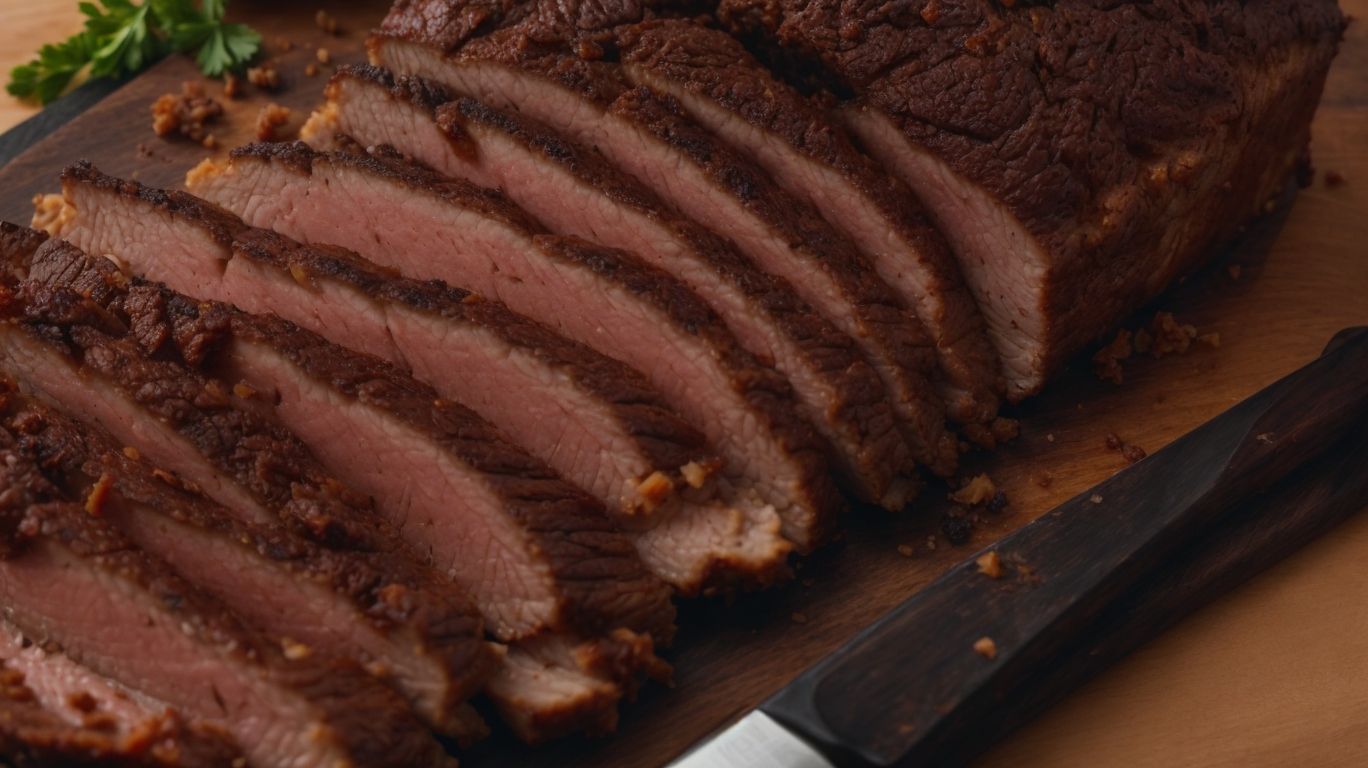
Credits: Poormet.Com – Mason Thompson
Determining the doneness of brisket involves monitoring the internal temperature, tenderness, and juiciness of the meat for optimal results.
When cooking brisket, using a meat thermometer is crucial in ensuring accuracy with the internal temperature. For a perfectly cooked brisket, aim for an internal temperature of around 195-205°F (90-96°C) for that melt-in-your-mouth texture.
Another key indicator is the fat layer; as it renders during cooking, it enhances flavor and moistness. Keep an eye out for the bark formation, that crusty exterior full of flavor, indicating the development of rich flavors. Achieving the right balance of texture and flavor is what separates good brisket from exceptional brisket.
Serving and Enjoying Your Brisket
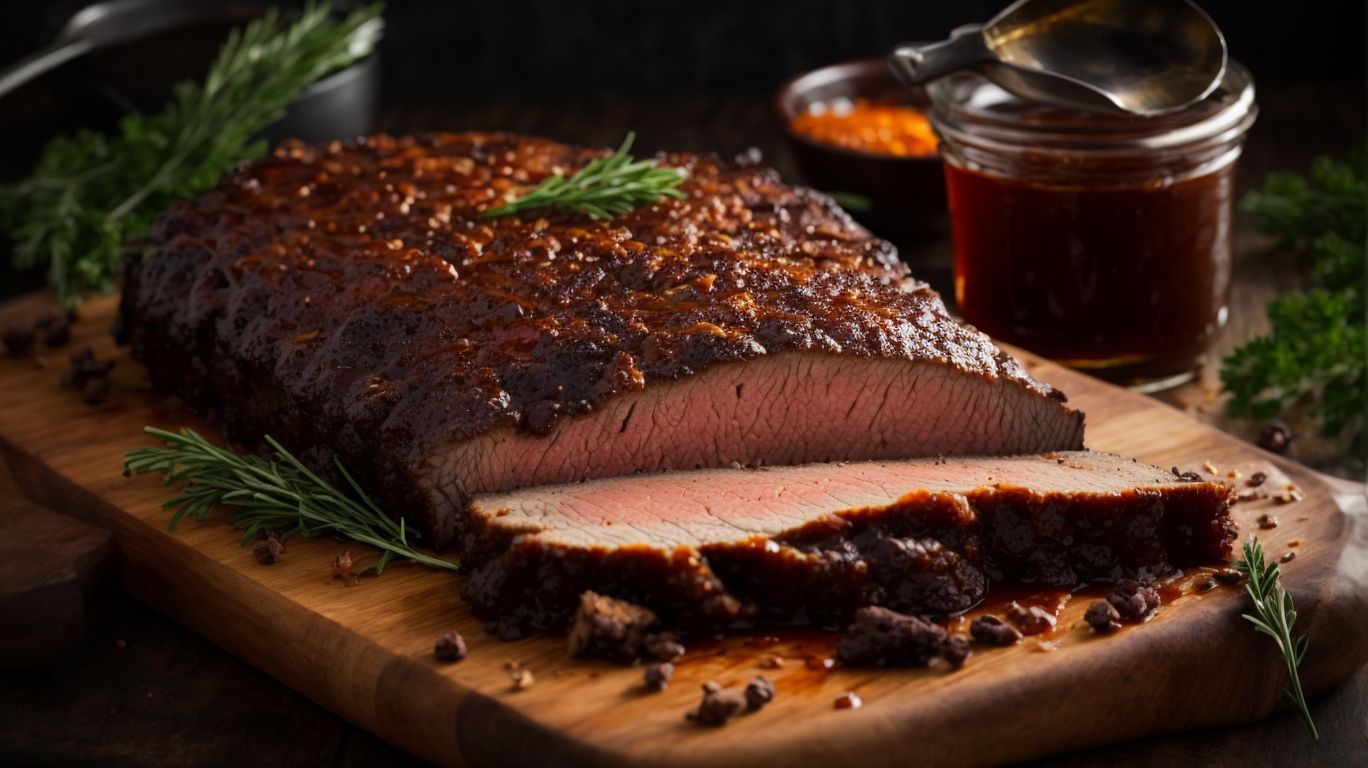
Credits: Poormet.Com – Larry Jones
Serving brisket involves artful slicing, creative presentation, and pairing with complementary side dishes for a memorable dining experience.
Regarding slicing a perfectly cooked brisket, the key is to cut against the grain to ensure tenderness and optimal texture. Aim for thin slices to highlight the smoky flavor of the smoked meat. For serving suggestions, consider pairing brisket with tangy barbecue sauce, pickled onions, or creamy coleslaw to balance the richness of the meat. Garnishes like fresh herbs, chopped scallions, or a sprinkle of flaky sea salt can elevate the dish further.
Slicing the brisket
Mastering the art of brisket slicing involves cutting against the grain, maintaining uniform thickness, and preserving the meat’s juiciness and tenderness.
Regarding brisket slicing, a sharp knife is crucial to ensure clean cuts through the succulent meat. Opt for a long, thin-bladed carving knife to achieve precise slices. Angle the knife at about 45 degrees to the cutting board to produce uniform pieces that showcase a perfect balance of lean and fat. Remember, the grain direction of the brisket is key – slicing against it ensures each bite is tender, flavorful, and easy to chew. Finely sliced brisket not only enhances the taste but also elevates the dish’s presentation, especially when drizzled with a rich barbecue sauce. The result is a delectable harmony of flavors and textures that is sure to impress any lover of smoked meat.
Serving suggestions
Pairing brisket with savory sides, tangy sauces, and fresh accompaniments can elevate the dining experience and create a harmonious flavor balance.
One creative serving idea is to slice the perfectly cooked brisket thinly and serve it on a platter surrounded by a variety of colorful roasted vegetables like carrots, bell peppers, and zucchini.
For a Tex-Mex twist, you can shred the brisket and use it as a filling for tacos or enchiladas, topped with spicy salsa and creamy guacamole.
Adding a drizzle of homemade barbecue sauce to the brisket before serving can enhance its smoky flavor profile and add a touch of sweetness.
Storing leftovers
Properly storing leftover brisket ensures its freshness and flavor integrity for future consumption, whether for reheating or repurposing in new dishes.
When storing leftover brisket, the key is to choose the right containers. Opt for airtight containers or heavy-duty aluminum foil to keep the meat from drying out and absorbing odors from other foods in the fridge. Another important tip is to separate any burnt ends from the rest of the brisket to preserve their unique texture and flavor.
To maintain the taste and texture of the brisket when reheating, consider using methods such as gently warming it in a low-temperature oven wrapped in foil or adding a bit of broth to keep it moist. Avoid using the microwave, as it can dry out the meat.
For a creative twist on repurposing brisket, try incorporating it into dishes like tacos, sandwiches, or even salads. Adding spices like cumin, paprika, or chili powder can enhance the flavors of the brisket and give it a new dimension in your recipes.
Frequently Asked Questions
How to Cook a Brisket Without a Smoker?
Can I still get a smoky flavor when cooking a brisket without a smoker?
Yes, there are a few techniques you can use to achieve a smoky flavor, such as using wood chips or liquid smoke.
How to Cook a Brisket Without a Smoker?
What is the best type of meat to use for a brisket?
Beef brisket is the most commonly used cut, but you can also use pork brisket or even turkey brisket.
How to Cook a Brisket Without a Smoker?
How long does it take to cook a brisket without a smoker?
It can take anywhere from 4-6 hours to cook a brisket in the oven, depending on the size and thickness of the meat.
How to Cook a Brisket Without a Smoker?
Do I need any special equipment to cook a brisket without a smoker?
No, you can use a regular oven and some basic kitchen tools to cook a brisket without a smoker.
How to Cook a Brisket Without a Smoker?
Can I still get a tender brisket without a smoker?
Yes, by using the right cooking techniques, you can achieve a tender and juicy brisket without a smoker.
How to Cook a Brisket Without a Smoker?
Are there any alternative cooking methods for a brisket besides using an oven?
Yes, you can also cook a brisket in a slow cooker, pressure cooker, or even on a grill using indirect heat.

